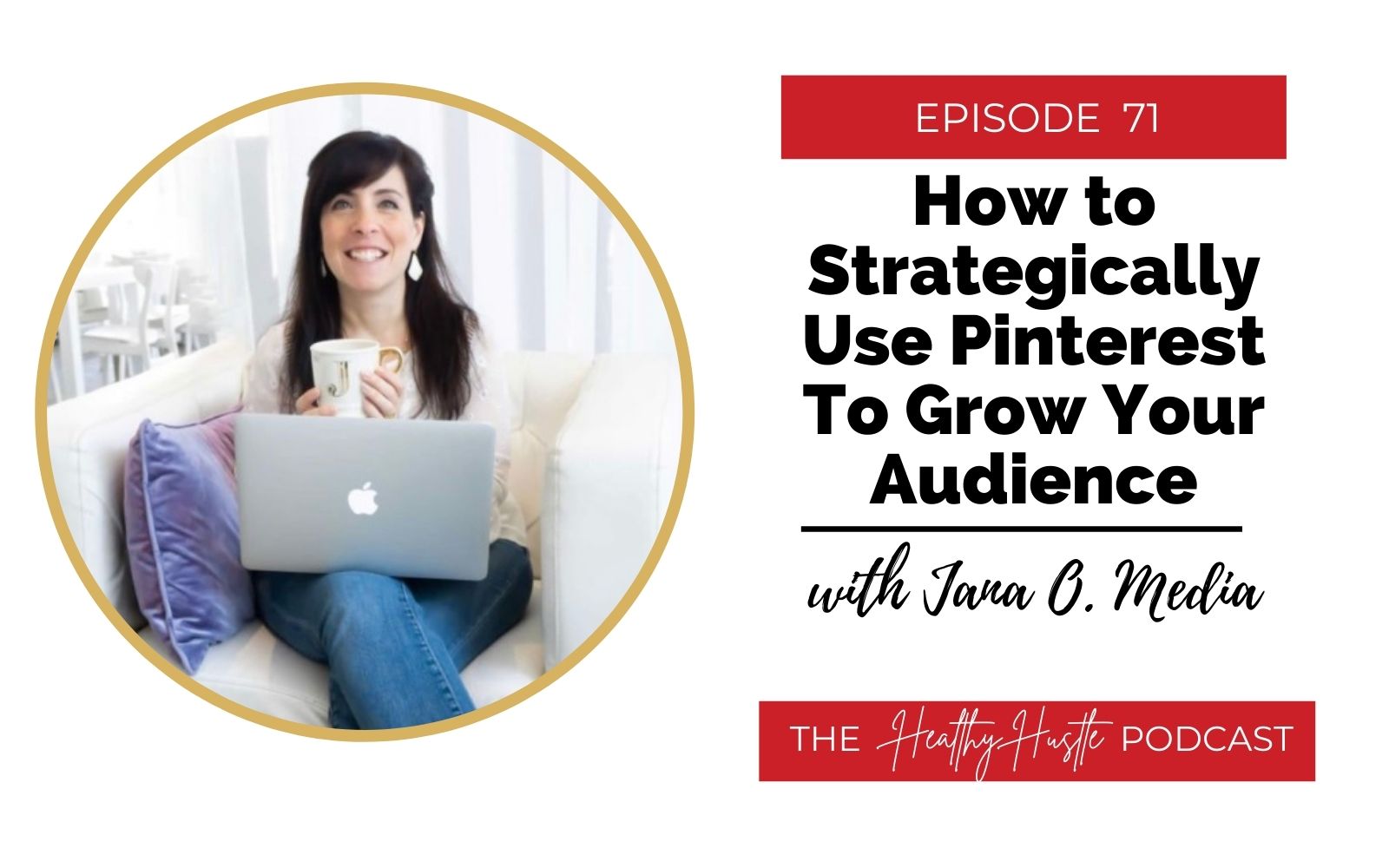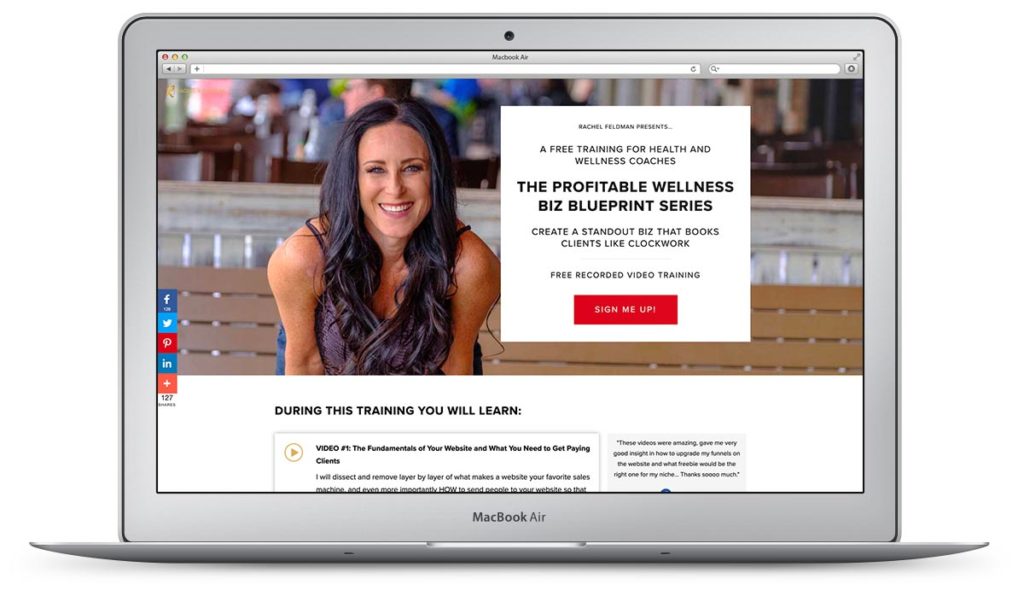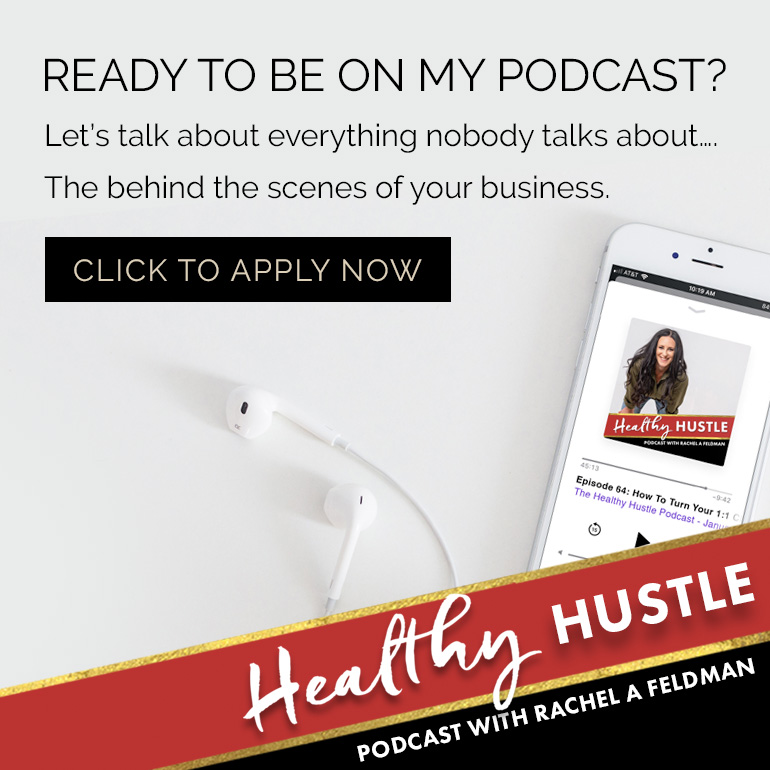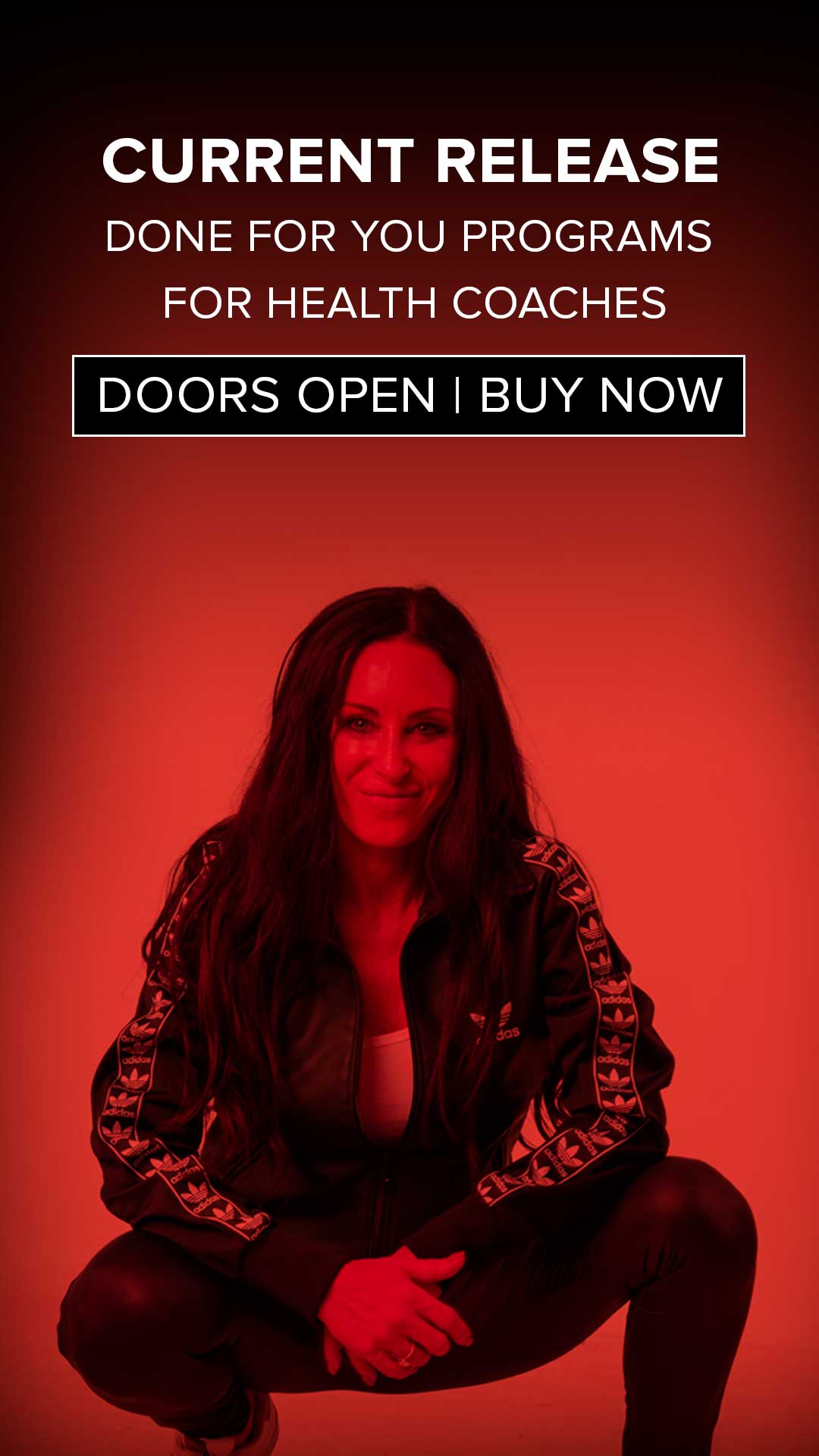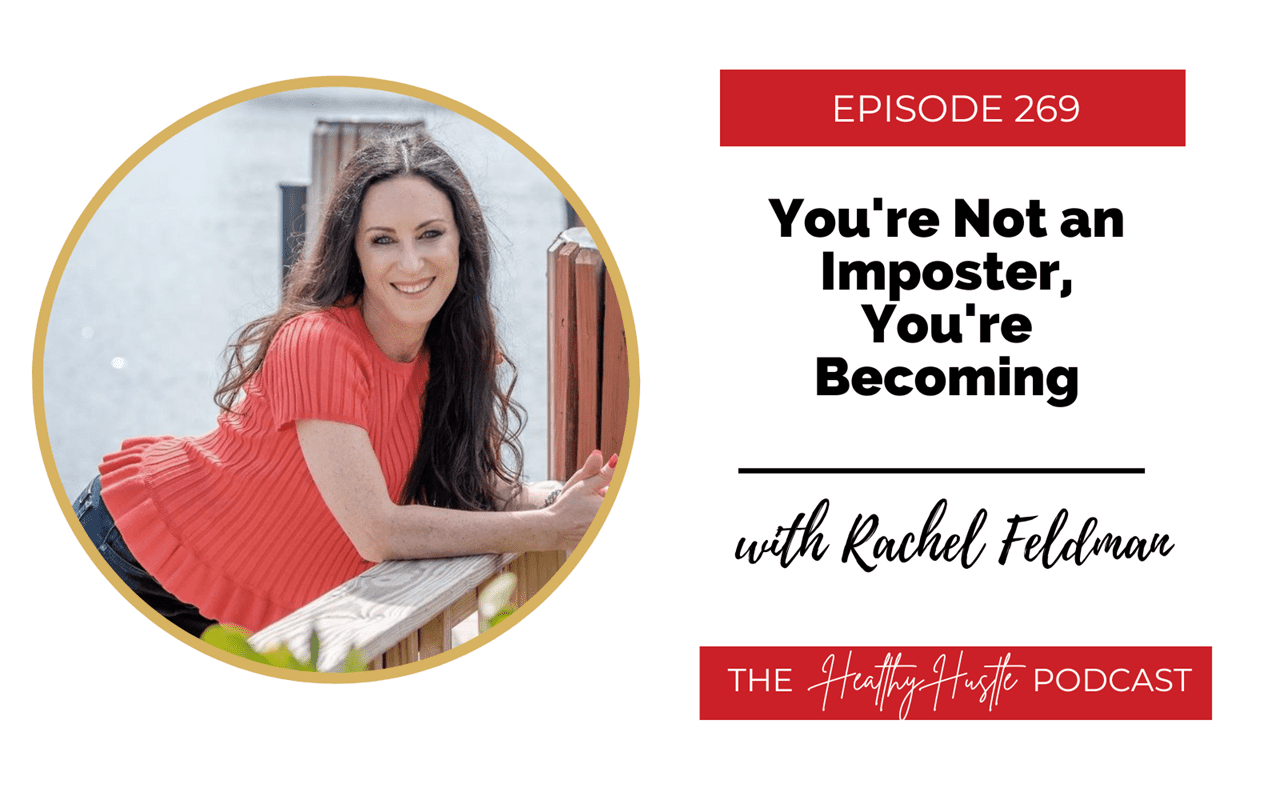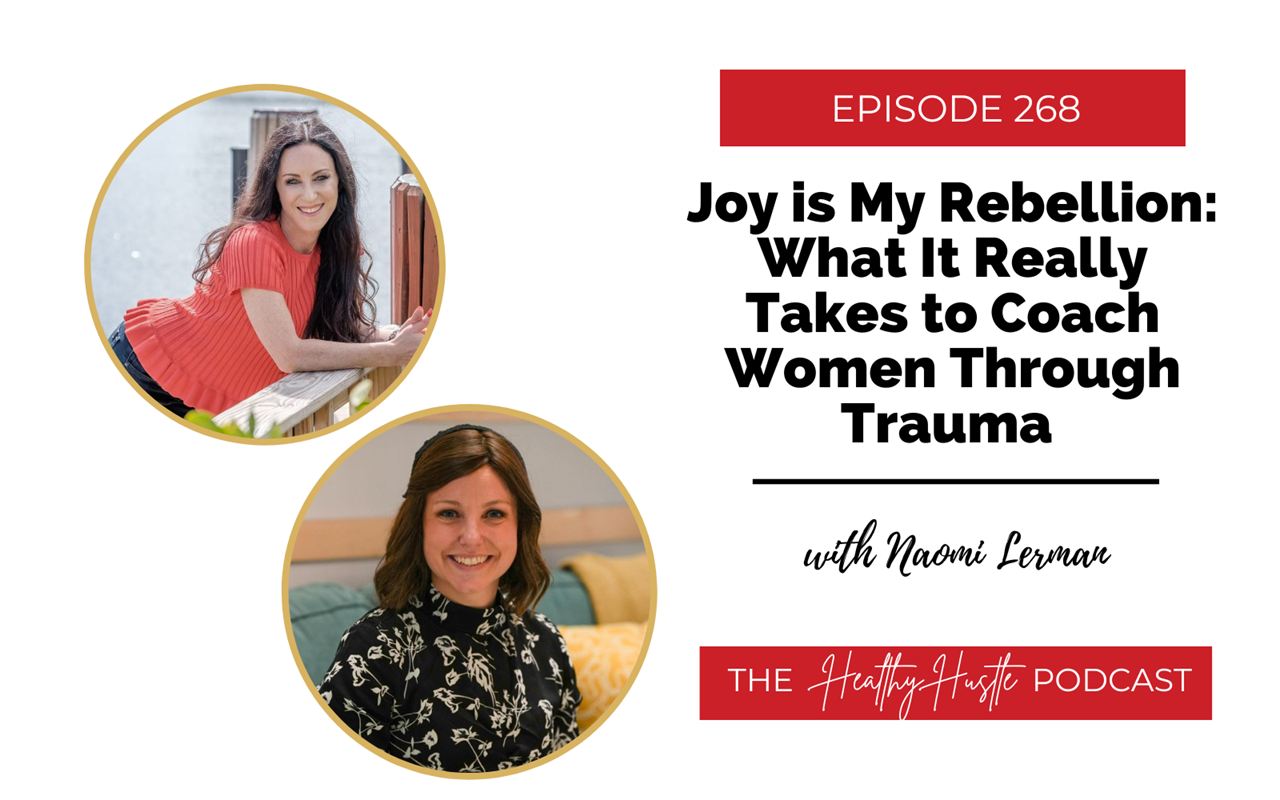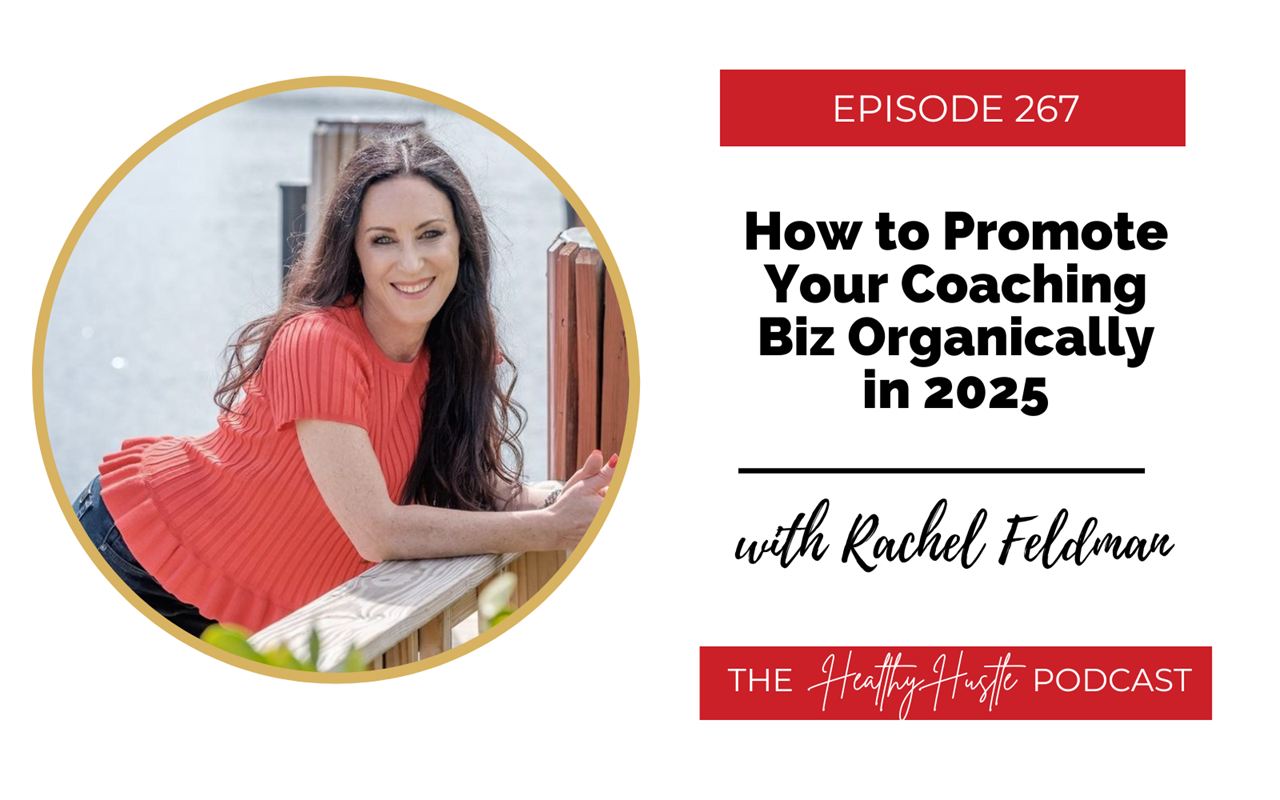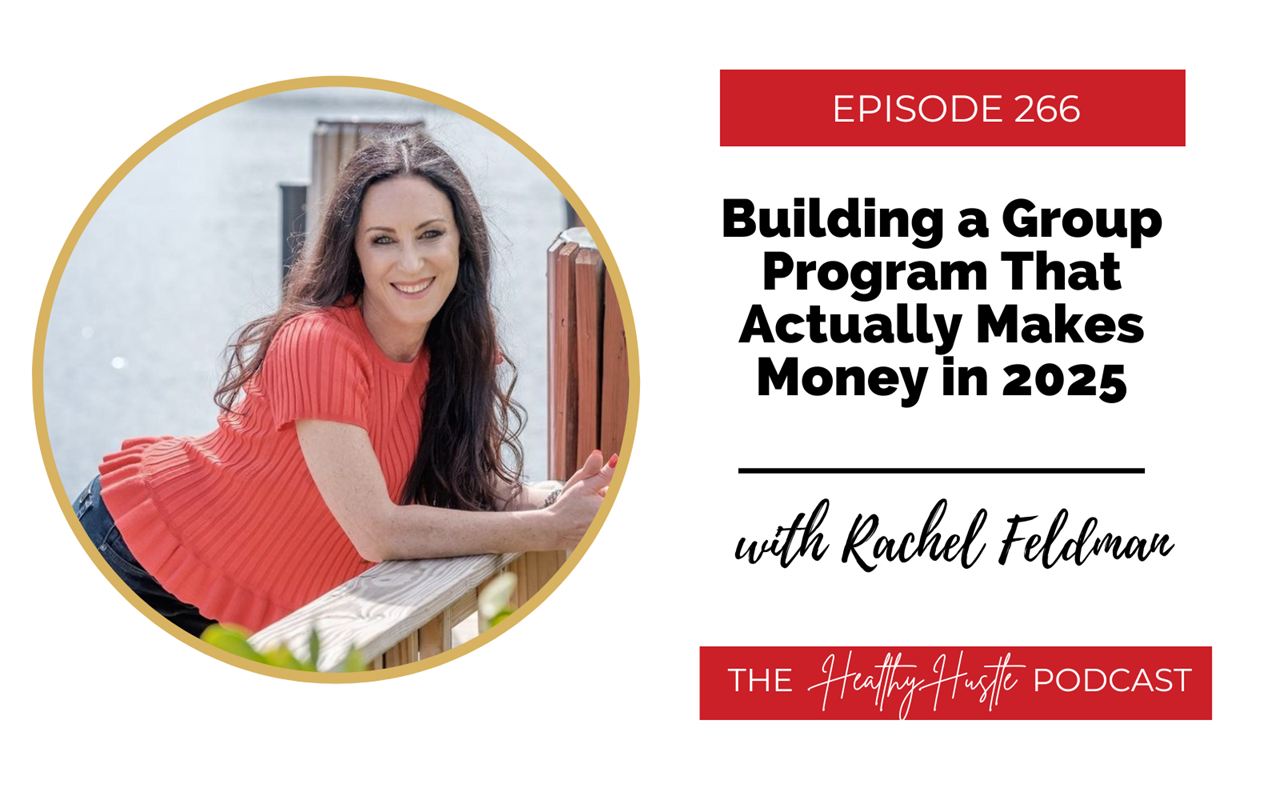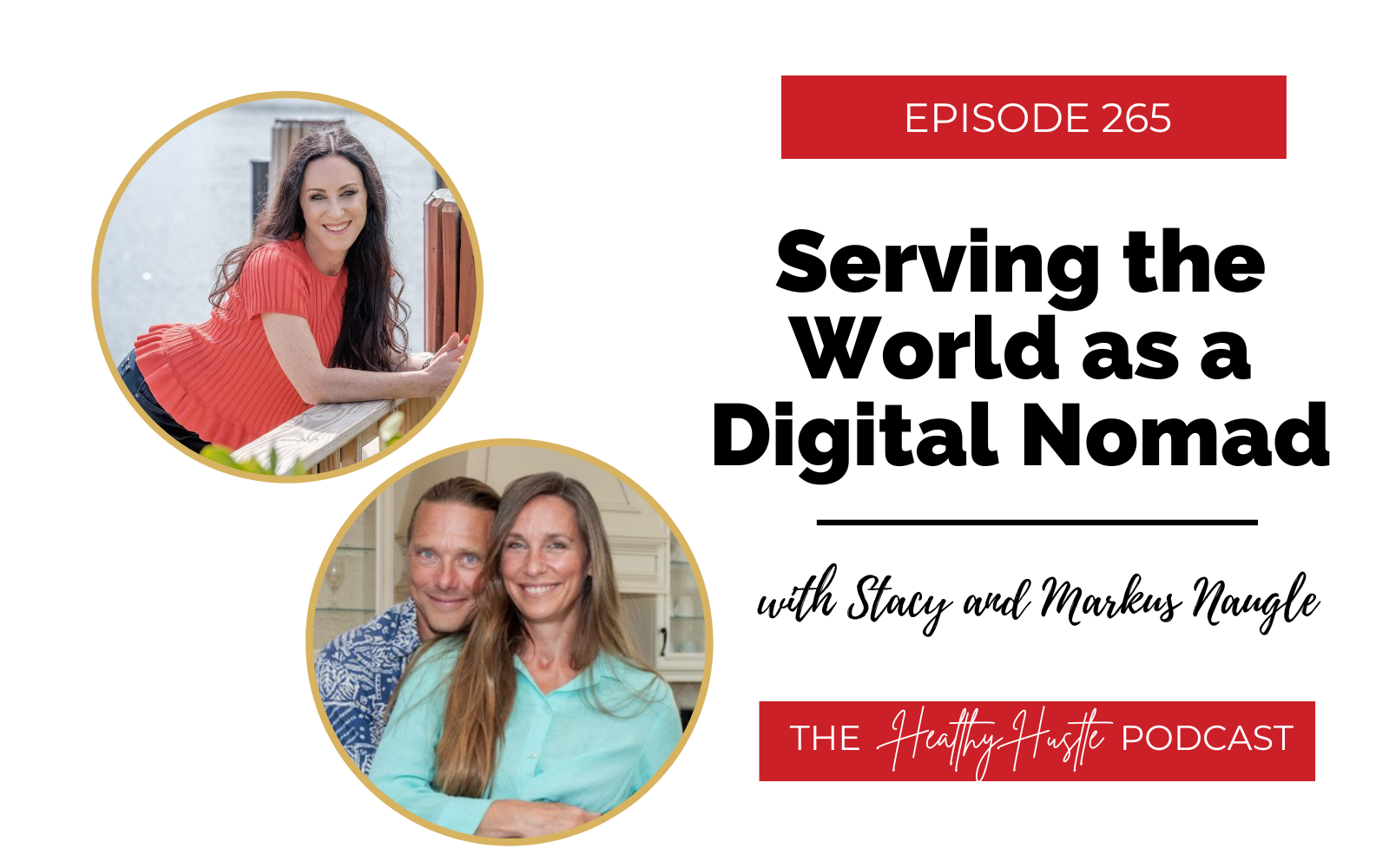Who is Jana O?
Rachel: I am beyond pumped to have this just marketing genius woman master telling you how to pin without feeling pin overwhelmed. So today we are going to be talking about how to three x your Pinterest without making you feel crazy and Jana is even going to talk to us about the beauty of Pinterest and really about your ideal client all this amazing stuff. So yes, it is going to be juicy. It’s going to impact. Take notes. Sign up for this woman’s freebie.
I know from personal experience in my group, she is the bomb.com with dropping information that completely applies to your life, your health and wellness space.
Jana: Oh, my gosh, what an introduction. Thank you. I am really, really excited to be here too. I’m Jana, with Jana media. And I’m a Pinterest marketing strategist for online coaches, and I work with a lot of coaches who are under like the self-development umbrella. So health coaches, wellness coaches, self-care, relationship coaches, and some business coaches too.
Because as we all know, running a business is the ultimate self-development experience, right?
So I help coaches to leverage Pinterest as a platform, basically, to grow their audiences on autopilot and attract perfect clients. Pinterest, as many of your listeners already know, is a search engine. So the beauty of it is that when you mark it on Pinterest, if you do it the right way, and you approach it like a search engine, which not everyone knows to do, but if you do approach it strategically, you can attract people who are already searching for the things that you help with and teach about and help with through your coaching program.
So it’s a really great way to bring in new people to your audience regularly and to bring in action takers because you can attract people who literally already know they need what you have. So I love it.
Why Pinterest Is Her Go-To Platform
Rachel: You talked about Pinterest being a search engine machine. And for those of you guys, if you don’t like search engines, go Google SEO and your mind will be blown by these amazing platforms. And it’s one of the big reasons I wanted you to be here on the show.
I tell coaches all the time, I know that you share about all these different strategies. And what I want to start having you guys think about is: Where are you posting that has a direct relationship with Google and is also a search engine?
So can you break this down for coaches, why is Pinterest your favorite tool for expanding and finding your ideal client?
Jana: Yeah, absolutely. So for the reasons I mentioned, because you can get attract action takers, as long as you do it strategically. I also love Pinterest, because it’s a search engine, it isn’t as high maintenance as social media is. So when people say to me, oh my god, I can’t even think about adding Pinterest to my list right now because I already have Facebook and Instagram and this and that. And I’m already on so many social media platforms.
One of the things I always remind them is a Pinterest isn’t social media. So when you set it up, you set it up as understanding that it’s a search engine. And the methodology that I teach requires you – once you have it set up strategically – to invest about four to six hours per month in one monthly setting. And then you set it and forget it until the next month. So you sit down you do like a half a day of stuff. And by the way, you can totally delegate all or some of it, it’s definitely easy to delegate stuff once you have it set up strategically, and then you literally walk away and come back 30 days later.
So you know a lot of people think of Pinterest or like Instagram because they’re both beautiful and pretty. But like over on Instagram, we all know you can have the best content but if you’re not in there engaging and dropping comments and talking to the people and searching hashtags and commenting on blah blah blah all that stuff.
Which is cool, I do it too. But if you’re not doing that engagement, you’re not going to get results on Instagram. Over on Pinterest. It’s the opposite. You actually don’t want to be DMing people on Pinterest and commenting on things. It’s not part of the culture. People don’t expect it. It’s not necessary for results. And actually, I’ve had people like I’ve seen people get banned for commenting on stuff too much. And sending DMS, if you get a DM on Pinterest, you’re like, What is going on? Right?
People don’t go to Pinterest, women don’t go to Pinterest, to socialize. It’s not social media, right, they will go there looking for ideas and inspiration about how to make their lives better, and how to make their businesses better. And if you can be there and show up in the searches for the things that they’re looking for, when they’re looking for you and those things you teach about. And that’s the magic there.
To answer your question, that’s the other thing that I love about it really is that it is low maintenance, as long as you have it set up strategically, and you understand what it is and what it isn’t. It’s not something that you just have to add hours and hours to your list of to-dos in order to be successful with which is great.
So I love those two things about it – that search intent and the low maintenance aspect of it. And I just love that it’s something that can be operating in the back of your business, and you can walk away from it. And you can be doing other things and it’s generating leads for you. That’s like the holy grail to me of lead generation platforms where you can walk away and be focusing on other things, whether that’s things in your business or in your personal life and know that it’s working in the background.
Rachel: To me that not only feels great from just a strategic perspective, but it feels like freedom. So I love that you brought up even the visual aspect because I know for myself when I think about different social media platforms.
And I always say everything that I learned was it was either self-taught or was trying to test out sales, especially before I either had a business coach or I was working with somebody like yourself who that was their jam and their zone of genius. I always would say, well, Instagram is a place just, like a visual museum. And I love going there to consume and I love going to different hashtags and seeing and quietly going through.
But when it comes to me intentionally searching, I always would say, Well, what are my behaviors? As a mom, I would always go and look at recipes on Pinterest.
My sister in law, still to this day is like, Oh, of course, I found this on Pinterest. We have an ongoing joke that every birthday party, everything she’s ever wanted to buy, every redo of a room was all from Pinterest. And I realized that it is a visual search engine machine.
So I would really love it if you can help this person who’s saying, Well, where do I even start? I’m sure you have something on your site for the basics of Pinterest. But for this coach who says, well, Jana, how can I use this strategically a few times without hiring somebody?
How To Start On Pinterest
Jana: Yeah, that’s a great question. And I do absolutely have resources on my website. And some of them are free. I have a free masterclass. And I have a free quick start checklist. And those are both great free resources for anyone who just wants to dip their toe in.
The masterclass is great because it basically helps you understand not only that Pinterest is a search engine because like a lot of people know that now. But it helps you understand what that means and what the things are that you need to understand that are kind of like those sub shifts. It’s called the 5 Secrets of Getting Clients Using Pinterest. And it basically goes through the five things that are the answer to these questions.
So Pinterest is a search engine. But what does that mean? How does that change? What do I do now? How does that change how I approach it? How do I set it up and what I do? So that’s a really great place to start if you just need to understand why you’re going to approach it and how you’re going to approach it differently. And it’s very actionable.
My quickstart checklist is basically for that person who just wants to jump in and get going with it and really wants to take those first few steps in order to get that fire under their butt and be like okay, now I have this great profile. And now I really want to do things like keyword research and things like that to make it really really perform really well for my business. But the nice thing about that checklist is it’ll have you do things that are actually going to set you up for a good strategy.
Unfortunately, I have talked to so many coaches who’ve taken my course or found me for one to one services. And when they found my course or my services, they were like, I already have Pinterest set up. They knew it was a place where their people were but they just jumped in and started creating boards. And started pinning things. And put their profile up and added a picture. And even made some pretty board covers. And then some of them say to me, but then I stepped away, and I watched it. And it isn’t doing anything for them. They didn’t see any results from their efforts.
And so what happened, in that case, is typically that they didn’t know those things about it being a search engine, those five secrets that I cover in that masterclass. And so those things basically roll out from the fact that it’s a search engine. And the number one thing I would say that people really want to skip their keyword research. They don’t want to take the time to get clear on who their ideal client is. It’s important to be clear on who that is. But also who your ideal Pinterest pinner is and what those people are actually searching for around the items that you teach and help with. Because that’s the first key. If you do that, you’re setting yourself up for having a strategic profile. Not just one that’s pretty and sits there. And you’re wondering, is this going to do anything for me?
If you actually start with your keyword research and say, Okay, what do I think people are searching for? Do some really good, really good work around that and then taking those words and phrases that you brainstormed and systematically researching them and finding out exactly what people really are searching for. Because there will be some surprises, you’ll be surprised when you do that research. And then you take those keywords and add them to like six areas of your profile. That’s where you’re going to end up with a strategy.
Rachel: Set it up strategically. That’s the answer. Yeah. Especially for anyone who is either new or more seasoned and looking to really grow and scale. We hear this word strategy a lot. Strategically do this or reverse engineer that. I love that you really go into detail because that gives somebody like myself, or anyone else, this roadmap and really covers these core steps. And in addition, it also gives insight into how important Pinterest can be, and also how it can really work for your business.
I think this is a perfect lead way into understanding why we need to be doing our market research and understanding who is consuming on that specific profile. I’ve never even looked at that. Who’s that person who consumes on this platform?
Can you just talk about how you do that market research to get your opinion person?
How To Conduct Market Research On Pinterest
Jana: So there’s a couple of different things I can think of that could be helpful there. One of them is, if you’ve been on Pinterest for a while, whether it’s strategically or even if it’s not really strategically yet. Maybe you’ve just been doing that thing that I described where you created boards, you started pinning, you’re on there.
Sometimes when people do save the pins that you create, and this is something a lot of people don’t know you do, you can look at each individual pin. And if you find the top three or four pins that you’ve pinned in your analytics, and you actually click on them, it’ll open them up in a bigger window. And then you can actually hit on this little button that’s kind of hidden that says more info on that pin. And it’ll give you expanded statistics about that particular pin.
Now you chose the top three pins because you want more data to look at rather than a lot of data to look at. So you should open that pin and see a decent amount of data because it’s one of your top three pins and one of the things you can actually look at.
As you can see what boards people save your pins to. So this was really interesting. Like, I have a hormone health expert who’s a client of ours. Maybe every six months for each of the clients that we work with, the Pinterest manager and I go in, and we do this little market research video to show the client this. And so we go in, and we look and we say, okay, you know, these pins have been pinned to 28 boards, and we go through each board and actually see what those are called. And that helps us to know, from our perspective, it helps us to know, make sure we’re keywording things correctly, because theoretically, those pins should be pinned to relevant boards.
If we see that someone is pinning them to weird boards, then we might not be getting in front of the right people. But for her, let’s say it’s a pin about how to deal with fibroids. If we see that people are pinning those to women’s health and to hormones and to fibroids and to 2021 feel better plan and boards like that, then we know we’re on target.
Then you can also look at those and get an idea of what kind of boards those people have. If you want to take the time to do this, this is a great way to do market research. It’s not something I recommend as a baseline Pinterest marketing strategy, but it’s a great place to go. So you can go into each of those 23 boards that your top pins were pin to and click on the person and see what other boards they have.
You can see, okay, this person also has a board about being a good role model for my kids. And she also has a board about homeschooling, and she has a board about this and that and you can kind of start to understand if there’s commonalities, and you know what other things are important to these people. And sometimes that stuff is like, oh, who cares? But if she has a board, there’s gonna be certain things that are like more adjacent topics and that would be really interesting to see for those people.
So that’s one way you can start. When you have this ideal client, in your mind, their avatar, their demographics, their habits, what they do, then, guys, this means that you literally can start making more pins that have to do with their boards.
Rachel: Which leads us into this next part which is marketing.
Pinterest Marketing
Marketing is making this assumption of what this person wants to consume from you in a flat form and how they consume it. Is it a podcast audio, a freebie, a blog, PDF? What actually makes them stop that image and say, Oh, wow, I’m gonna opt into that?
That’s why marketing experts are really great, because all they do is geek out on hard data and give us more data, more information. So we really create that content that appeals to your ideal client. But also at the same time we need to make pins and write messages with those same pieces of content without having to reinvent the wheel 50 times. And then do your self care and take care of your family, right?
Jana: That’s a great topic. And I think I have some ideas about it that are at the intersection of those two things. I mean, I definitely teach a minimum viable Pinterest strategy. I believe there are a lot of shiny objects you could chase on Pinterest, just like there are shiny objects anywhere. It’s just a little microcosm, right. So I really encourage people to stick to the basics.
So I think a coach who has clients and who is marketing in multiple places, not just Pinterest is not going to be set. If you’re not spending all day, every day on Pinterest, you need to be able to walk away from it and that’s why I teach that methodology of maintaining it and whatnot. So I agree with that 100%. I think that if you’re being smart about it and you’re focusing on the things that are going to give you the ROI which are going to be your keywords and those visuals that you just mentioned.
I actually just wrote a blog post recently it’s called How to 3x your Pinterest reach without 3x in your content creation and that’s exactly what you’re talking about. We were breaking it down here.
But so many entrepreneurs need this, they need this visibility. But they get stuck saying, Well, I’m already in all these other platforms. How am I contrasting? And furthermore, being really strategic on Pinterest is making sure that you’re testing what you’re getting, so that you’re bringing in direction having that person to opt in without needing to create 10 more pieces, right?
How To Use Your Content For Pinterest
So I know you, Rachel, are prolific content creator, and some of your people like creating content, some don’t. In reality, we’re all creating content, because content is just solutions. When you are creating solutions for people and explaining the solutions to their problems and helping them to get there, that is content when you’re creating that right.
So one of the things that’s great about Pinterest is that it magnifies what you do have for content. So say you write an epic blog post as an example. And it doesn’t even have to be epic, just a blog post about like 10 snacks. This is an example I use a lot 10 snacks that you can have on hand, or even five snacks that you can have on hand that you know give you more energy that you can have for like afternoon snacks that aren’t coffee, there’s got to be a more concise way to say that for a blog post title, but you know what I mean, five, five energy boosting snacks to have on hand for your 2pm slump that aren’t coffee or something like that.
So in that article that I wrote that blog post and instead of just creating one pin for that blog post that you took a while to write, you want to make the work you’ve done really work for you. That’s the strategy part. So instead of just creating one pin and popping it up on Pinterest and calling it a day, you can create multiple pins for that piece of content. And so when you first create that piece of content, whether it’s a podcast episode, a YouTube video training, a blog post, whatever that is, you can create three or four pins for that content. And then down the road Two months later, you can revisit it and say, Oh, this is performing really well. I’m going to create more pins for this piece of content. And a lot of people don’t realize that. So for a lot of people, even people who are on Pinterest.
If you’re doing that, there’s basically three main benefits of creating multiple pins for each piece of content, the first one’s obvious, it just increases your reach, because you’re pinning more. And there are more opportunities to have, you know, people find those pins and their searches and smart feeds. And you can use different keywords and that kind of thing.
The second main benefit is – actually I’m going to skip to the third and come back to the second because we really want to talk about the second, it’s the most fun one. The third benefit is that you can pin more and space them out, and you won’t look like you’re pinning the same thing over and over again. Because you’re creating multiple pins for each piece of content.
But backtracking to the second benefit. And it’s sort of related to what you were talking about is you can create different pins with different messaging and different angles. So let’s say you have that piece of content, it’s about five energy boosting snacks, that won’t crush your adrenals for that 2pm slump. And let’s say you create one pin that shows a picture that has the text overlay that I just said. So you know, that’s what it’s about. And it has a picture of a mom running around outside in a sprinkler with her kids. And so that’s going to attract someone who would love to have more energy, because she’s finding herself at two o’clock every day her kids are like mom want to go out and play and she’s like, No. But she doesn’t want to be that mom. And then another pin, you could have another one where it says, 5 afternoon snacks that boosts your energy. So you can be more productive pointing to that same blog post, because that is the same topic and it’s congruent with what they would get if they click through because they still get that list of blueberries and you know, the different snacks that are going to be good for you at that point. But maybe this one has an image of a woman, you know, in her 30s and she’s at home in her pajamas on her laptop working, you know, and she’s really obviously focused, like maybe it’s a work from home kind of situation, right? And so for her, she’s hitting this two o’clock kind of afternoon. I know I do sometimes. And she knows that she still has client work to do. You know, she’s an online entrepreneur, she’s got to finish her workday, but she’s feeling probably because she’s sitting there in her pajamas. She could just wash her face, but blueberries will probably help too.
So that pin is going to attract a different kind of person. And then obviously, you get to make a decision as the CEO of your business, whether you want to attract both of those markets or not. That’s you know, your decision. So the text overlay you use, the image that you use,
and even the keywords that you use can help attract different people to that same piece of content and get to have different angles.
So I always say your pin has two jobs. One is to stop the scroll. Because when you’re on Pinterest, most of us know if we’ve been on Pinterest or scrolling and you’ve got to just stop and get their attention. And one of the best ways to do that is to just be really specific about who that pins for.
It’s that you hear your at a cocktail party phenomenon where you’re in a room full of people, you’re chatting and someone says your name across the way, it’s like, immediately your ears perk up, and you look over, that’s the same concept if that person scrolling, and it says energy boosting snacks, and it shows a woman out there within the sprinkler with their kids. The messaging is there. Both the copy and the visuals are immediately telling her that she’s in the right place, if she wants to have more energy in the afternoon to be in the sprinkler with her kids. So the idea there is to know your person. What problems they’re trying to solve, and show that on your pin so that they stop the scroll.
And then the second job of the pin is to get them to get that micro conversion, which is getting people to click through the pin and get that piece of content, because I want to know what those five things are easy to shop for and easy to get and should have in my refrigerator. So when I hit that two o’clock slump, and I don’t want coffee, I can go grab my snack and feel more energetic.
But the only way to get that is to click through that pin. So you want to give people that incentive that there’s something here for them that’s going to solve their problem.
Rachel: Would you say that if I were that really busy entrepreneur, that it would make the most sense to open up Canva, have a template for your pin and just say here is message and picture that shows maybe that mom that’s running around with her kids. Another picture that shows the blueberries?
Jana: Yep. And then the third picture is that picture that shows the woman either maybe she’s at her desk at work, maybe she’s doing them at home, either, but it showed that lunch, that’s zero, that situation and the fourth is to have that blueberries with so that you’re really testing the same. So it’s almost instead of blueberries to blueberries, it’s apples to apples.
If you’re looking to test to either reach a couple of different audiences – you basically open up Canva. And for every piece of content, you’re creating four pins. One is for this person, one is for this person who’s a different part of your audience. And then this one takes a strategy, that would be a great way to do it. And you’re right there is the ability to do market research there.
Understanding Your Audience’s Response On Pinterst
So an example of that might be you want to find out on Pinterest, are people responding better when you push into their pain points? Or are they responding better when you offer them the solutions? So maybe one pin is, do you want to have more energy because you want to run on the sprinkler? Maybe another pin shows what the opposite of that looks like.
Remember Pinterest takes time. So you have to give it a chance. But if you, over time, see that people are responding better and clicking through your content more when you’re pushing into pain points, or maybe when you’re offering the solution instead, you could that gives you an idea, you know of which strategy works better.
I think like probably on most platforms, we know that we want to do both. We want to have some content that hits one or the other. Generally speaking on Pinterest, they say that the positive messages work better because people go to Pinterest for positivity. But I’ve found with some clients that that doesn’t hold true that it is the pins that have people on them who are unhappy, because they are uncomfortable because of those fibroids as opposed to the women who feel free now and they’re on the top of a mountain.
I always say in the health and wellness industry, there are blueprints, maps or rules and there are strategies. But you have to come back to a place where you say I’ve absorbed all this information, and now I need to test it. And I need to see which one works for who I actually try. And I think that there are more sensitive topics, that fibroids and colitis and when you come in more into that dizzy state where you can actually go for that elephant in the room and say is sex really painful and have a woman with her head down and feeling sad. Or you can also say, imagine the horror or death or no 10 foods to help you know, five blades so that you don’t have pain and this woman like exactly or this woman who just had great sex or something
One of the things I hear people say constantly is, oh, this isn’t working, then right away, I say, is that actually not working or have not tested enough to really understand what grabs the attention of your ideal client in a really busy digital world?
Rachel: Yeah, like, are you struggling at home? And feel overwhelmed at your desk? If they want to say that woman who was like, yeah, or have your child they wanted to see that transformational experience? Yeah, that pain. So I love that you’ve talked about this and made it so simple, because that coach can say, Oh, well, I keep posting – but maybe you’re posting this food when that person needs to identify with a person and that visual. You go into Pinterest and see, this one’s doing really well as a pin. You have a clear indication, I should make more of those.
Understand Your Pin’s Analytics
Jana: Right, exactly. So you can, you can look at your analytics and Pinterest. Andthe dashboards are really easy to use, you can literally open up your top 10 pins from the last 90 days, and then see if there’s any commonalities. And if it seems like the positive messages are working better, great double down on that. And if it seems like this particular, lighter, brighter graphic is doing better than a darker one, great double down on that.
Infographics, too. I think we see so many types of content on Pinterest. I know I’m a Canva addict. Okay, say it’s a great place to just start to start testing out to realize how we consume information is different for each one of us. Yeah, but that we can test things out to see, does this person like seeing the food? Does this person want to see a picture of me as your brand identity? And like, Oh, that’s that person? Or do they need to see a stock photo?
Yeah, I totally agree with all that. The only caveat I would say to that making those types of decisions – when you have enough data – is to be able to see those commonalities, it’s probably going to take you six, nine months, to get to the point where you have enough data on Pinterest to be able to see to be able to make to draw meaningful conclusions.
So one of the things I really help people do is to reduce the overwhelm of getting started and focus on the keyword research, the visuals, and then putting a workflow in place that you can easily do for four to six hours a month, once a month, and then walk away until the next month. And that four to six hour workflow that I teach the very first phase of that workflow is the housekeeping phase, where one of the things you do is you look at your analytics. So you are going to be able to start to see those patterns. But it’s going to take a while to get to the point where you have enough information to be able to say oh, this is working or this isn’t working. So I would say for the 60 minute I mean how many times have you been a marketing tragic and really drill down your focus on Pinterest.
Rachel: Now, how many times have you seen this just in business that takes time and I think that’s a part of many people quitting before they actually see the hard data? Does somebody need to hire a person to really help me get into that deep down data?
Like, I get overwhelmed. I’ve learned from hiring somebody and having them walk me through the process. That’s a duplicatable process. Once you learn that.
Why Pinterest is a long game
Jana: I think that that was exactly right. And that’s important to add into the mix. But I agree with you. One of the things that’s interesting about Pinterest is that there is a little bit of a barrier of entry to some degree because it is a slower moving platform. And you don’t always see results right up front. I will say in the health and wellness and self care niches, the accounts that I’ve seen that do grow a little faster than some of the other niches that I also help with. So it’s maybe not as much of an issue but it’s still an issue, like people still get three, four months in, they’re like, Okay, I’m doing this every month, and I’m not seeing any ROI. So I’m going to walk away and stop doing it. And that’s not a good idea because Pinterest, it just grows really, really slowly and everyone that I’ve seen who’s exploded their traffic and their leads from Pinterest. It’s taken, you know, six months, nine months a year.
So for me, it’s like that image of a guy who’s mining for gold, and he’s just mining every day, he goes out there, and he’s mining and mining. And he’s building this mine, and he’s getting closer and closer to gold. But he doesn’t know if it’s there or not. But we can see it as the audience. We know, he’s getting closer. And then one day, he just says, This is it, I’m sick of doing this, and he stops. And he’s like this far from the gold. You know what I mean?
That’s the image that I have of Pinterest, because I think a lot of people get started with it. And even if they do get started with a strategy, a keyword strategy, they still sometimes don’t put enough time into it to see it grow. There’s like this inverse relationship between what you have to put into it in the beginning, and the results you’re getting, and then the results snowball over time, and meanwhile, it gets easier and easier to manage it. So less and less time and effort have to go in because you’re getting better at it, and you know what you’re doing right? And then your results snowball. But if you don’t give it that chance to like, have that cross over time, you know, to sort of get to that point where they cross over, then you’re not going to get there, and then you won’t have that data.
Rachel: I love that you’re giving a little more roadmap for how advantageous it actually can be. And that it really is about refining that market research and understanding that it’s not that you have to put in so much work later that it will get to a point where that data is there. And it will give you a clearer picture. When do people typically start doing paid ads or paid pins? Is that something you recommend in the beginning? As long as you haven’t set it up?
Paid Ads On Pinterest
Jana: Yeah, yeah, it depends on what you want from those paid ads. So I used to, if you’d asked me this question a year ago, I probably would have said, Well wait, you know, six to nine months and then start running ads.
So I would say you know, set up your system, find out what that data is and then run ads based on the pins that are working the best, you know what I mean? Because that way, you’re putting money behind something that’s already working.
That being said, recently, Pinterest pins have become more popular on there more strategies around promoted pins, which is basically what Pinterest called its ads. They’re called promoted pins. And I have seen some people who are actually putting a little bit of money behind each of their pins. I have a student in particular who took my course who I was on a call with probably about three months ago, she had taken my course and got everything set up strategically. And because she was going on maternity leave, she wanted things to heat up faster. And so she decided to start paying like $4 or $5 for each of her new pins every month. And I thought that was really interesting.
That’s not something that I have personally experimented with, because I focus more on the organic strategies. But she was doing that. And she said that she was getting, you know, faster growth and faster results. So if you’re not satisfied with what I just described, where it’s going to take you at least six months, nine months a year, and put up with the low money.
I’ll tell you almost all of my core students and my clients, it’s taken them that long to look back on this and be like, Oh, my God, this is amazing. I’m so glad I did this.
I heard many years ago somebody talked about Active Campaign like no joke, like seven years ago, somebody was like this is going to be up and coming. And they were right. And I feel the same thing with Pinterest. It’s such a great place to be.
Rachel: Do you run any Facebook ads in your own business? You do? Do you have your students running Facebook ads at all? Or are they at a different stage in their business? I would say most of my one on one clients are running Facebook ads, okay, maybe they’re doing them by themselves. I’ve always made myself personally been like, Okay, my brain is really good at certain things. But like, I’ve got to outsource that part. And so I tell people, unless you’re really good at doing your own stuff, outsource it.
Jana: It’s great to get leads on Pinterest and then retarget example Facebook.
Rachel: Yeah, I was just gonna say that. Yeah, I know you and I know you know that because you’re a strategist, you’re a marketing person. But yeah, there probably are a couple people listening for whom this is going to blow up.
Jana: The idea that you can get cheap leads by getting targeted people over to your website from Pinterest. These are people who want those five snacks for energy boosting. So there must be people who are unhappy with the amount of energy they have at two o’clock right now, right? So they get over to your website, and then you can retarget them when they get warm.
How Facebook Ads Build On Pinterest Leads
Rachel: And I think that’s the part where I know there are a lot of Facebook ad courses. I mean, I’ve even bought them. And this is when I really had to have that moment with self and I was like self, you’re not great at consuming information. I’m all for courses. I mean, God, we not only sell them, but I tell people all the time, you have to figure out how your brain processes. I do great when I consume a course with one on one attention.
So I joined a membership on Facebook ads and said, You know, I just have to actually put this to the side and know that I always need a little more one on one support, because of how my brain processes. I tend to get a little overwhelmed. I just need that extra personalization. Honestly, I don’t understand Facebook ads. They’re hard to understand.
Pinterest, at least for now is much, much less complicated than that. I don’t know if it will become more sophisticated with the targeting and stuff but it’s you know, it’s not as complicated as that. So it’s nice even with a retargeting ad if it took me a while to really understand there are different types of ads.
Yeah, that you’re paying significantly less for retargeting, because that person is already warm audience, they’ve already opted into something you have their pixel. So guys, for any of you who are working with somebody this is really homerun when we’re talking about scaling and growing on other platforms, but a huge advocate of having your information.
So is that something that you actually wanted to do, paid ads?
Jana: Yeah. So there’s kind of like I said, two approaches, you can go for: the organic strategy first and have that all set up and then down the road, pour the gas on it with the ads.
Those are typically my clients. However, I have recently had some people come to me and say, I just kind of want to set up like the minimum viable Pinterest account. And then I want to immediately jump into the ads. And that can work too. So there’s a little while to get into it. But I do that.
And I also have an ad strategist who is not on my team, per se, but she’s a referral partner. So we’ve been doing this, we’ve done this for like a few clients recently. We set up the account but not in the same same level of detail that I do in my done for you offer where I’m focusing on the organic strategies.
But we set up the minimum viable piece so that the ads are possible and then work. And that is definitely a possibility. If someone wants to invest more money up front and less time, really. So it’s really kind of depends on people’s goals. I try to figure out which of those models might work better for them.
Rachel: We’ve really looked at so many different strategies and all of us at any stage have to be reminded, constantly to say, am I doing this enough? Am I really tapping in to what people want? Then you really start to look at what is proven? What works? What’s consistently getting love? And don’t just fall for that shiny object.
Mastering One Platform
Jana: Yeah, absolutely. And I think really, you know, one of the things that paralyzes people is they just think they have to do all the things, you know what I mean? They’re like, and a lot of people. Like I said earlier are just like, oh my god, Pinterest. I already have all these other things on my plate. But I think if you really look at what you’re doing, I mean, none of us unless we have a huge team of people, and we’re comfortable delegating, none of us can be literally on all the all the platforms and do that well. So to me, it’s all about having at least one platform that you’ve mastered that where you’re nurturing people, the people that are new that are coming into your audience, and then having at least one platform that is getting you new people into your audience all the time, that’s constantly working without you even having to think about it, and bringing new people into your audience.
Bringing New People Into Your Ecosystem
Some people use Facebook ads for that. My people use Pinterest for that. Pinterest is really a place to bring new people into your ecosystem. It’s not a place where we nurture, right, because there’s no DMing and there’s no conversations and you’re not commenting and we’re not going live on Pinterest. We’re not making that nurture connection, we’re bringing new people who didn’t know that we teach about energy boosting, lifestyle type of stuff. And now they do and they’re being brought into our ecosystem because they found us in a search or a smart feed.
So if you have one platform that you’ve mastered, where you’re nurturing and one that you’ve mastered, or you’re bringing new people in, you’re good. And then once you master it, then you can layer in other strategies.
Coaches On Pinterest
Rachel: A lot of people don’t know the ins and outs of Pinterest and over the years and having you always sharing groups relative to home to health based services and personal growth. Wellness coaches have definitely learned. And it’s expanded my understanding of Pinterest. And it’s been really helpful when I was almost to the point of like, Okay, I’m not going to take this on right now. Because Yeah, my brain for it. But yeah, I said, Oh my god, you know, how, what does it look like to work with you? Because I started to understand that potential. Yeah, so understood.
Before we get going, I always like to ask one question. If you had $5,000, what would you invest in?
Jana: My massage package is running out. So I have a massage package that I bought when a spa that I like here in tow. They’re running like5 for 1, and I’m down to my last one. It’s the best and I feel like it’s such a great way to unplug and feel good. It’s definitely like filling your own cup which is not easy for me to do on a regular basis. I would definitely just invest that entire amount into whatever number of massages I could get in that package.
Rachel: What is a sacral massage? What is your favorite health hack? You are that person who loves your business and works with a lot of people to keep yourself grounded and centered and all that good stuff, huh?
Staying Grounded & Centered
Jana: To keep myself grounded and centered. My first thought was my favorite health hack. I don’t know if it’s about grounding and centered but I worked with a health coach about two years ago I would say for about six months because I was in a place where because I started my business four years ago right and then I got burnt out. I didn’t literally burn out but I was in danger of it.
So I did a six month coaching engagement and one of the things that I walked away from that she taught me, that I kind of already knew, but she helped me get consistent about it and I still have stuck to this habit every single morning. When I wake up before I do anything else I drink 22 ounces of room temperature water. So I leave it on my bedside at night and I drink it first thing. Before coffee, before I check my phone every night I just guzzle 22 ounces. It seems like it’s a lot but you’re thirsty when you first wake up so it’s not hard at all. And the room temperature makes it easier to drink it all down. And I was floored, shocked by how much of a difference it made to my morning energy.
Rachel: Wow. I love that. So, you guys are gonna follow this one and you’re gonna download her free stuff, you’re gonna consume our guide because she’s so strategic.
Connect with Jana:
Website: https://janaomedia.com/
Masterclass Freebie: 5 Secrets For Getting Clients Using Pinterest – https://janaomedia.com/masterclass-register/

